What We Saw At Immersed: The Virtual And Augmented Reality Event
Immersive technologies such as virtual and augmented reality are charging toward the market at a breakneck pace. Tom's Hardware is dedicated to this exploding industry, so we were the media sponsor of the first annual Immersed conference in Toronto on November 23 and 24.
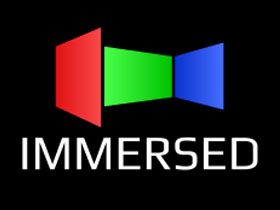
Immersed stands out for a few reasons. For one thing, it's rare to see a VR/AR event on the east coast. California is at the heart of the tech industry in North America, but progressive companies on the other side of the continent are also staking a claim. Immersed gives them an opportunity to strut their stuff a little closer to home. In addition, this smaller, brand-new show brought us some fresh perspectives from smaller players. Giants like Oculus, Samsung and Sony weren't present to steal the limelight.

From a technology standpoint, we saw some intriguing products. Montreal-based indie developer VRVANA demonstrated the Totem, a potential competitor to the Oculus Rift that features two cameras for 360-degree positional tracking and could allow for augmented reality applications, too. We've known about the Totem for a little while, but this was our first opportunity to try it out for ourselves. It's an early working prototype, and the unit's enclosure appears somewhat rough around the edges as it's manufactured on a 3D printer, but it works. It's Rift-compatible, and we watched a demo that showed the headset's potential.
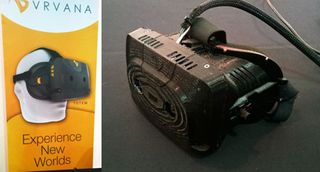
We also saw a few HMD mounts for smartphones. The most elaborate of these is ImmersiON-VRelia's GO, an accessory that accommodates mobile products with displays between 4 and 6 inches. We're told the GO is fairly close to release, and pre-orders are already being accepted. It's a slick package that comes with a custom-built VR/AR software interface called AlterSpaceAVR. In addition, the company is working on PRO head-mounted displays expected to ship in mid-2015. The PRO version does not require a smartphone, as it's a self-contained unit like Oculus' Rift.
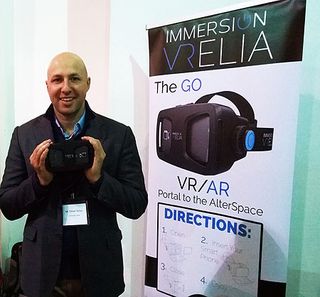
Pinc VR is another accessory designed to transform your mobile device into a head-mounted display, but it's a little different in that it folds down to perform regular duty as a smartphone case. It also makes use of sensor rings for the user's fingers, which provide a hand-driven interface in the VR space. This Toronto company's product is built exclusively for the iPhone 6 and 6 Plus in its initial iteration, and Pinc VR is now raising funds via Indiegogo for a $100,000 startup goal.

If you're into VR, you've probably heard of Google Cardboard, the entry level do-it-yourself head-mounted display for Android smartphones that's made of low-cost household components. Deep (an acronym for "Digital Entertainment for Every Platform") is a media production company that's interested in expanding the audience for immersive content, and it has developed a solution even more compact and cost effective than Google's. It's expected to cost in the $10 neighborhood. Of course, this Toronto-based company is more focused on the 360-degree media content that it continues to pioneer, such as the impressive documentary The Polar Sea.

Immersive Media is another company on the forefront of developing immersive 360-degree experiences, and it had a Samsung Gear VR on-hand to showcase some demos. It was this writer's first experience with Samsung's entry into the VR space, and I found it did a decent job of delivering 360- degree panoramic video. I was treated to Roddenberry Entertainment's White Room: 02B3, a short independent sci-fi film that takes place in a single room with the viewer watching from the center. There was a bit of latency, but I think it's a serviceable platform for video delivery, although I'm not sure how well it will handle 3D content. We'll be producing a full review of Samsung's Gear VR as soon as we can, though.
Stay on the Cutting Edge
Join the experts who read Tom's Hardware for the inside track on enthusiast PC tech news — and have for over 25 years. We'll send breaking news and in-depth reviews of CPUs, GPUs, AI, maker hardware and more straight to your inbox.

Speaking of video, there were a few companies at the show that provide 360-degree cameras capable of capturing 3D content. iZugar showed its Z6X3D, a six-camera solution contained within a single capture device. The data it captures can be stitched together by software, and 3D information can be extrapolated. The result isn't seamless or a perfect rendition of 3D, but at the $2000 mark we're not aware of any comparably-priced camera solutions that are capable of this feat.

JauntVR is another company that offers cameras for capturing VR experiences, but it focuses on high quality production and boasts an end-to-end solution of hardware and software production tools. We were impressed with the company's first publicly released VR experience, which is a recording of Paul McCartney playing "Live and Let Die" in front of a massive crowd, all from a perspective right beside the piano he's playing. It's a very compelling demo, and the quality level is very high, although there remains some slight stitching artifacts between the cameras.

Next, Galaxy is a company that's tightly focused on VR and AR and is building a software platform it calls Ceek (pronounced "seek") to cater to this specific audience. This software is interesting, although the tech is still in the development stage, but the company had some hardware to demo at the show, too: Ceekars. It's an audio headset and controller specifically designed to work with head-mounted displays, with an attached in-hand controller that allows the user to browse content and control their avatar in Ceek. Our Seth Colaner reported on this company's efforts earlier this month.
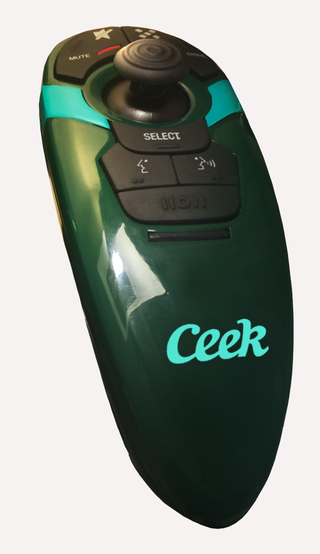
But it wasn't all about head-mounted tech at the show, with an interesting demonstration from a company called DTI that creates glasses-free 3D displays. (Our interview with DTI's Tom Curtin is here.) The need for polarized or LCD glasses is almost universally blamed for the slow 3DTV adoption rate, and DTI believes it has solved the problem with a glasses-free solution it calls the Mission-Critical 3D Monitor. I'm not yet certain how the technology works, but what I can say is that the company had a very convincing demo that involves software eye-tracking to deliver a 3D image to the user regardless of their position. DTI is working on a version that can track multiple viewers at once and claims that there is no resolution or quality loss. There's a current Kickstarter campaign to raise funds, and if it's successful, backers will receive a 27" monitor for just under a $1000 pledge.
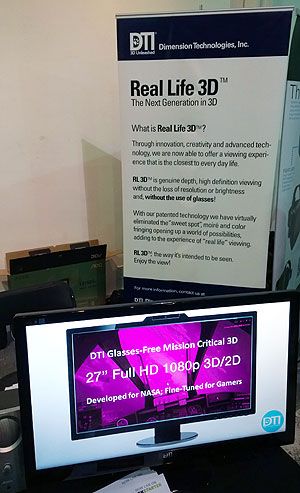
There were a lot of VR experiences to see at the show, the majority of which were Oculus Rift-enabled. Media agency SecretLocation showed off its creepy VR trailer for the show Sleepy Hollow, and the Canadian Film Centre's media lab demonstrated a Cronenberg-fueled dystopic VR fantasy entitled Body/Mind/Change. We also took VRChat for a spin, a virtual-reality social network complete with avatars and worlds for virtual citizens to interact in. We even played blackjack in a virtual casino presented by Lucky VR, and we can't help thinking there's probably a lucrative future in that.

Aside from the demonstrations, there were some interesting panels presented at the show. The highlight was titled "The Visionaries Speak," a panel that consisted of John Gaeta (visual effects guru for the Matrix trilogy and currently working at Industrial Light and Magic on the new Star Wars films, our interview here), David Traub (award-winning movie producer and creator of the display graphics in The Lawnmower Man), Neil Trevett (President of the Khronos Group), and Michael Page (assistant professor of 3D Visualization, Holography, and Multimedia at OCAD University). The resulting discussion touched on the potential benefits and disasters that VR might face in the future. One idea that stuck with me was the suggestion that virtual reality may become so emotionally compelling that we might one day see gamers suffer from post-traumatic stress disorder. It's a sobering thought.

I had the honor of chairing a panel called "The Electric Backbone of Immersive Tech" that discussed some of the hardware challenges that virtual and augmented reality have created. James Dolan (Nvidia), David Nalasco (AMD), and Colin Shin (Siliconarts) delivered fascinating perspectives on the graphics industry's struggle with this new media. It was great to hear them distill some of the important issues with this emerging platform, along with potential solutions.

Speaking of graphics card manufacturers, AMD had a booth showing off an asynchronous Eyefinity setup and Alien: Isolation in VR. It was cool to see monitors running at different native resolutions working together as a single display. As for Alien: Isolation, it seems to work very well with the Oculus Rift. It's a shame the developers didn't enable support directly in-game, as players who want to try it need to enable it via a hack.

We didn't expect to see any new graphics processor technology presenters, but a company called Siliconarts showed off their RayChip, a discrete ray-tracing GPU for mobile and embedded applications. We don't know the technical details of the company's IP, but the ray-tracing demonstrations looked impressive for an embedded solution considering the number of ray bounces that were calculated in real time.

As a VR enthusiast, it's inspiring to see how quickly the Immersed technology event came together. We think it speaks to the groundswell of interest in the budding virtual and augmented reality industries, and it was inspiring to be in a room with so many pioneers and forward thinkers. Tom's Hardware is proud to be a media sponsor of this event, and we can't wait to see what Immersed may bring in the years to come.
Follow us @tomshardware, on Facebook and on Google+.
-
Lmah VR is getting close to being mainstream, but they are also far enough away I don't see it taking off for another 5-10 years or so unless the technology greatly improves. But yes it is way more advanced than virtual boy in it's current state. Hopefully these companies are in it for the long haul otherwise we could be waiting longer.Reply -
JohnBugs I suspect many of these companies will crash and burn. Especially if you're essentially doing an Oculus or Gear VR clone. Pinc is unique enough to maybe take off.Reply
But exciting time for sure, looking forward to a good quality 3D camera!
Most Popular



